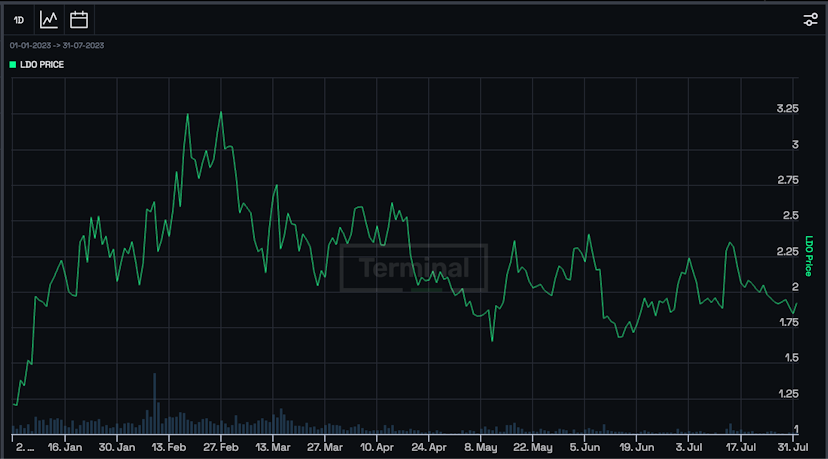Lido Enables Staked ETH Withdrawals With V2 Rollout
Liquid Staking Leader Looks To Silence Decentralization Critics With New Staking Router
By: Samuel Haig • Loading...
DeFi
Lido, the top DeFi protocol by TVL and Ethereum’s largest staking entity, deployed its v2 iteration on Monday, introducing staked ETH withdrawals alongside measures to expand its validator set.
Users have already requested to withdraw 429,000 stETH ($78M), according to Parsec. Staked Ether withdrawals were activated for the first time one month ago alongside Ethereum’s Shapella upgrade.
Celsius, the insolvent CeFi lender, accounts for the vast majority with around 420,000 stETH in withdrawal requests, according to Nansen, an on-chain analytics provider.
Despite being down 12% in the past month, Lido’s governance token is up nearly 80% in 2023.

Danny Chong, the co-founder of rival liquid staking protocol, Tranchess, believes the move will help to reduce the protocol’s dominance over the staking sector. “Enabling withdrawals mitigates the concentration risk of staked ETH by reducing the number of ETH held by a few validators,” Chong told The Defiant.
Lido is a controversial protocol within the Ethereum community due to its staking dominance, having amassed 31% of all staked Ether worth over $11B, according to Dune Analytics.
While Lido promised to disrupt what it feared could become a centralized exchange-dominated staking ecosystem for Ethereum, some analysts believe Lido has since become the very monolithic centralized staking entity it sought to vanquish.
“[Lido is] the only platform who has more than 22% of validators and openly seeks to capture the chain,” tweeted Superphiz, a prominent Ethereum community member.
Staking Router
The upgrade introduces Lido’s new Staking Router, providing a simple on-ramp for onboarding new node operators to the protocol.
With Lido v1, users’ Ether was distributed among 29 node operators, garnering criticism from onlookers unconvinced by the protocol’s claimed decentralization. The new module allows a wide range of users to apply to operate nodes via Lido from solo stakers to professional entities, bolstering the decentralization of its validators.
“The Staking Router architecturally shifts the Lido protocol towards an aggregator strategy… offering the possibility for different approaches, technologies, and greater overall flexibility throughout the protocol,” Lido said. “[Stakers] benefit from a more diverse and secure Node Operator set, as their deposits will be distributed over a much greater number of independent entities, mitigating network-downtime risk and improving Ethereum’s resiliency.”
Lido hopes to make node operator onboarding permissionless in the future by leveraging on-chain reputation, distributed validator technology, and bonding. It also encourages developers to design their own staking modules with unique specifications. Developers can apply for their modules to be included in the Staking Router.
Rocket Pool
The staking router service allows Lido to compete with Rocket Pool’s minipools, which enable users to launch a node with only 8 ETH and source the remaining 24 ETH from the protocol.
Rocket Pool is a rival liquid staking provider that allows anyone to onboard as a node operator. The project has been favored by decentralization advocates due to its distributed validator ecosystem, with more than 2,500 independent validators as of May 9.
That being said, Rocket Pool currently accounts for only around 578,000 staked Ether or just 3% of the network’s staked capitalization.
stETH Derivative
On Tuesday, Matt Losquadro of Synthetix, a decentralized synthetic asset protocol, said he is working on a governance proposal advocating for Synethix to roll out stETH perpetual contracts.
“If approved, this would be the first perps market to support [Lido’s] liquid staking derivatives,” he tweeted.
Advertisement
Get the best of The Defiant directly in your inbox 💌
Know what matters in Web3 with The Defiant Daily newsletter, every weekday
90k+ investors informed every day. Unsubscribe anytime.